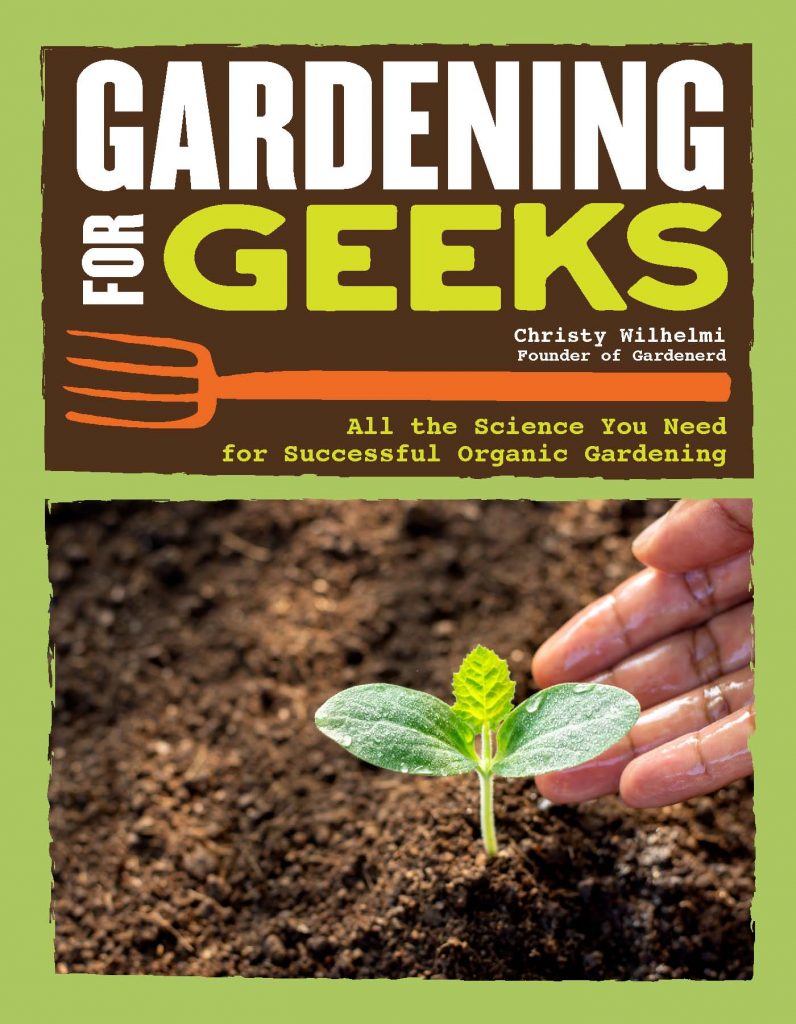
In this issue:
- July in the Garden
- Protecting & Harvesting Corn – YouTube
- Gardenerd Tip of the Month: Answers to Your Questions
- Gardenerd Product of the Month: Gardening for Geeks 2020
July in the Garden
Here in Los Angeles, Covid-19 case are on the rise, and I continue to offer consultations via Zoom. I’ve got my family to protect, so I’m wearing a mask when I go outside. I wish everyone else would too. When I talk to relatives living in Italy, they are back to normal, with cases completely under control. If we could just dial back our rugged American Individualism a skosh, we might be able to do the same.
The Test Garden continues to be an oasis in the midst of limited exposure. As summer heat comes on, we’re harvesting cucumbers, tomatoes, beans, basil, and oh-so-many summer squashes. Winter squashes and watermelons have set fruit and are rambling everywhere. Pole beans are flowering and setting fruit. Corn is sending up silks (watch our latest video about how to protect them). It’s time to feed these guys once again, to help keep them productive. We’re setting rat traps in an attempt to keep some tomatoes and peppers (Yea, peppers – even the hot ones) for ourselves. We planted a final round of lettuces in a shady spot for summer salads in a few weeks.
In this newsletter, you’ll find our latest YouTube video, and answers to Ask Gardenerd questions. Enjoy the summer as best you can while staying safe, and please wear a mask when you go out. It’s the best way to ensure our future freedoms as a whole.
Happy gardening,
Christy

2. YouTube: Protecting & Harvesting Corn
Our latest YouTube video walks you through the second half of growing corn. We talk about how to protect your crops from corn and army worms. We review the timing for when to start checking for the milk stage. And we give you a quick tutorial on how to harvest the ears. Go to the blog post for additional information to help you grow corn successfully this season.
Protecting & Harvesting Corn
3. Gardenerd Tip of the Month – Answers to Your Questions

We’ve recently received a slew of questions through Ask Gardenerd. Here are answers to a few to help you grow more successfully this season:
Tomatoes Brown on the Bottom – “What’s gone wrong with my tomatoes? ‘Red pear’ is the variety and it’s rotting or turning brown at the flower end on both the ripe and green. Thank You, Kim.”
Hi Kim, you’re not alone. The issue is called Blossom End Rot. It occurs when one of two things is happening: 1) Inconsistent watering, or 2) Calcium uptake issues. Fortify your soil with beneficial microbes (compost, compost tea, worm castings) to help assist with calcium uptake, and make sure you are watering deeply, especially in containers. When planting next year, drop a handful of Epsom salts in the bottom of each planting hole. This adds a little magnesium which also helps assist in calcium uptake as well. Listen to our latest podcast with Scott Daigre for this and more tips on growing tomatoes successfully.
Blossoms Dropping – “Why do buds fail to bloom? It is happening on a lemon tree and a rose bush in my garden. Buds form but then they turn brown and dry before opening up. Thank you! -Jerrine”
Great question Jerrine! When buds drop instead of setting fruit, it’s usually a nutrient deficiency, or rather, nutrients in the soil are not accessible to your plants. We generally recommend boosting your soil microbial life (as above with Kim) because those microbes are responsible for cycling nutrients back to the plant. If microbes go dormant or die (soil’s too dry, not enough compost/mulch as food for them, or highly chlorinated water) they can’t help the plants obtain nutrients. In some cases when blossoms turn brown and die before opening, there could be a disease at play. But that’s usually with camellias, not roses. Also, test your soil for levels of Phosphorus and Potassium. These nutrients are responsible for fruiting and flowering. Make sure your levels are sufficient and you’ll see a difference in production.
Beans Lacking Leaves – “I am growing Christmas pole lima beans. The vine is getting to be 6 feet tall, it does not have a lot of leaves except at the lower part of the vine. The runner keeps climbing the pole but not many leaves… what can I do? -M.Chawla“
Don’t worry, M., those lima beans will leaf out soon. The vines will have a lot of space between the leaf sets at first, but then they will take off making leaves and flowers. Because Christmas Lima beans act as perennials in warm-winter climates, they can take awhile to get going. But once they do, they will continue to produce for more than a year (they may take a break in temperatures over 85 degrees). As with the above questions, check your soil for nutrient levels and add compost and worm castings. They both have low levels of nitrogen that will help increase leaf growth, but microbes will access other nutrients in the soil. If the soil needs nitrogen, use a balanced organic vegetable fertilizer around the base of the plant and water it in. Here’s a blog post to help you along your journey as well (read the comments for suggestions too).
4. Gardenerd Product of the Month – Gardening for Geeks
Gardening for Geeks is available on Gardenerd.com, Amazon, Fox Chapel Publishing, and Barnes & Noble. This updated version will help you plant victory gardens for everyone in your family. It includes 6 new plant profiles, and updated resources and terminology. Some distributors still show the book as back-ordered, but we’re working with the publisher to resolve the issue. Stay tuned and…
Stay tuned for more tips and tidbits from Gardenerd.com. Happy summer gardening!

Search our archives here.

